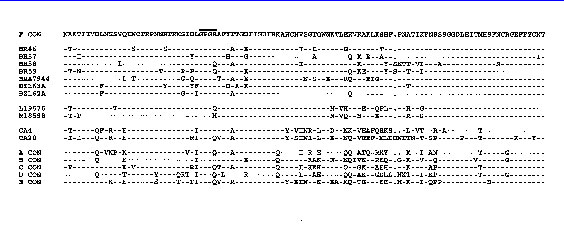Volume 1, Number 3—July 1995
Dispatch
Epidemiologic and Evolutionary Relationships between Romanian and Brazilian HIV-1 Subtype F Strains
Figure 2

Figure 2. Alignment of deduced amino acid sequences for envelope C2-V3 region of Brazilian and two representative Romanian HIV-1F subtype strains and their comparison with Cameroonian sequenes and the consensus sequences for some other subtypes. F CON represents consensus amino acid sequence (single letter code) for the Romanian and Brazilian F subtype HIV-1 viruses presented in this figure. Consensus sequences for the other subtypes are from Ref. 1. Amnio acids identical to the F CON are shown as a dash, and the dots represnet gaps introduced to align sequences. The top bar shows the peptide motif at the tip of the V3 protein loop.
References
- Myers G, Korber B, Wain-Hobson S, Smith R, Pavlakis G, eds. Human retroviruses and AIDS 1994: a compilation and analysis of nucleic acid and amino acid sequences. Los Alamos, NM: Los Alamos National Laboratory, 1993.
- Hersh BS, Popovici F, Apetrei RC, Acquired immunodeficiency syndrome in Romania. Lancet. 1991;338:654–9. DOIPubMedGoogle Scholar
- Dumitrescu D, Kalish ML, Klicks SC, Bandea CI, Levy JA. Characterization of human immunodeficiency virus type 1 isolates from children in Romania: identification of a new envelope subtype. J Infect Dis. 1994;169:281–8.PubMedGoogle Scholar
- Potts KE, Kalish ML, Lott T, Genetic heterogeneity of the V3 region of the HIV-1 envelope glycoprotein in Brazil. AIDS. 1993;7:1191–7. DOIPubMedGoogle Scholar
- Louwagie J, Delwart EL, Mullins JI, McCutchan FE, Eddy G, Burke DS. Genetic analysis of HIV-1 isolates from Brazil reveals presence of two distinct genetic subtypes. AIDS Res Hum Retroviruses. 1994;10:561–7. DOIPubMedGoogle Scholar
- Nkengasong JN, Janssens W, Heyndrickx L, Genotypic subtypes of HIV-1 in Cameroon. AIDS. 1994;8:1405–12.PubMedGoogle Scholar
- Felsenstein J. PHYLIP-phylogeny interference package (version 3.2). Cladistics. 1989;5:164–6.
Page created: December 20, 2010
Page updated: December 20, 2010
Page reviewed: December 20, 2010
The conclusions, findings, and opinions expressed by authors contributing to this journal do not necessarily reflect the official position of the U.S. Department of Health and Human Services, the Public Health Service, the Centers for Disease Control and Prevention, or the authors' affiliated institutions. Use of trade names is for identification only and does not imply endorsement by any of the groups named above.